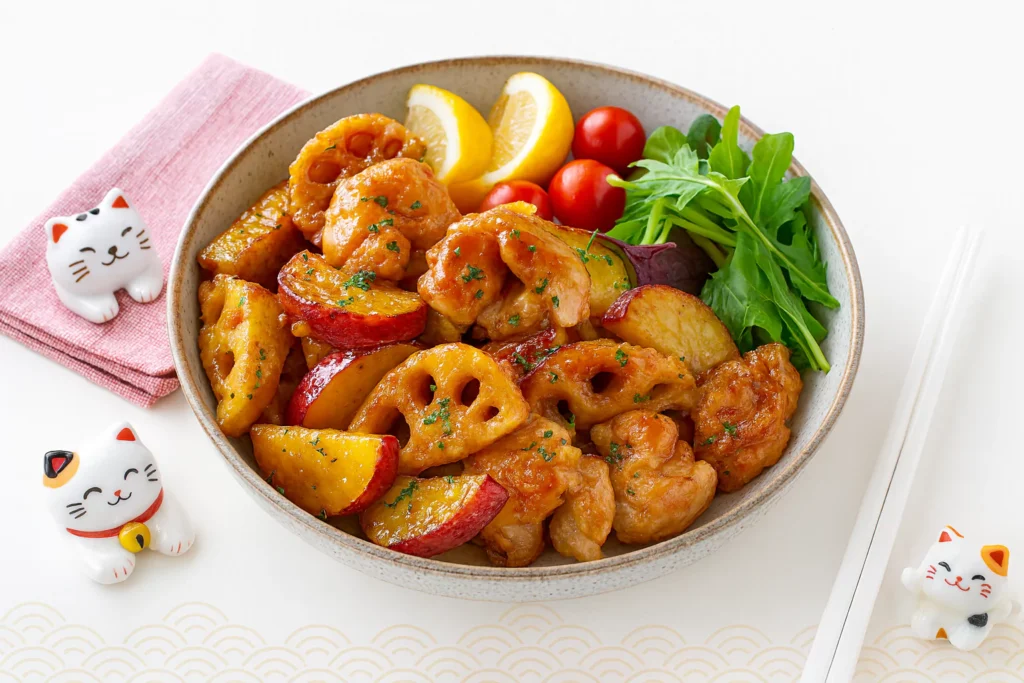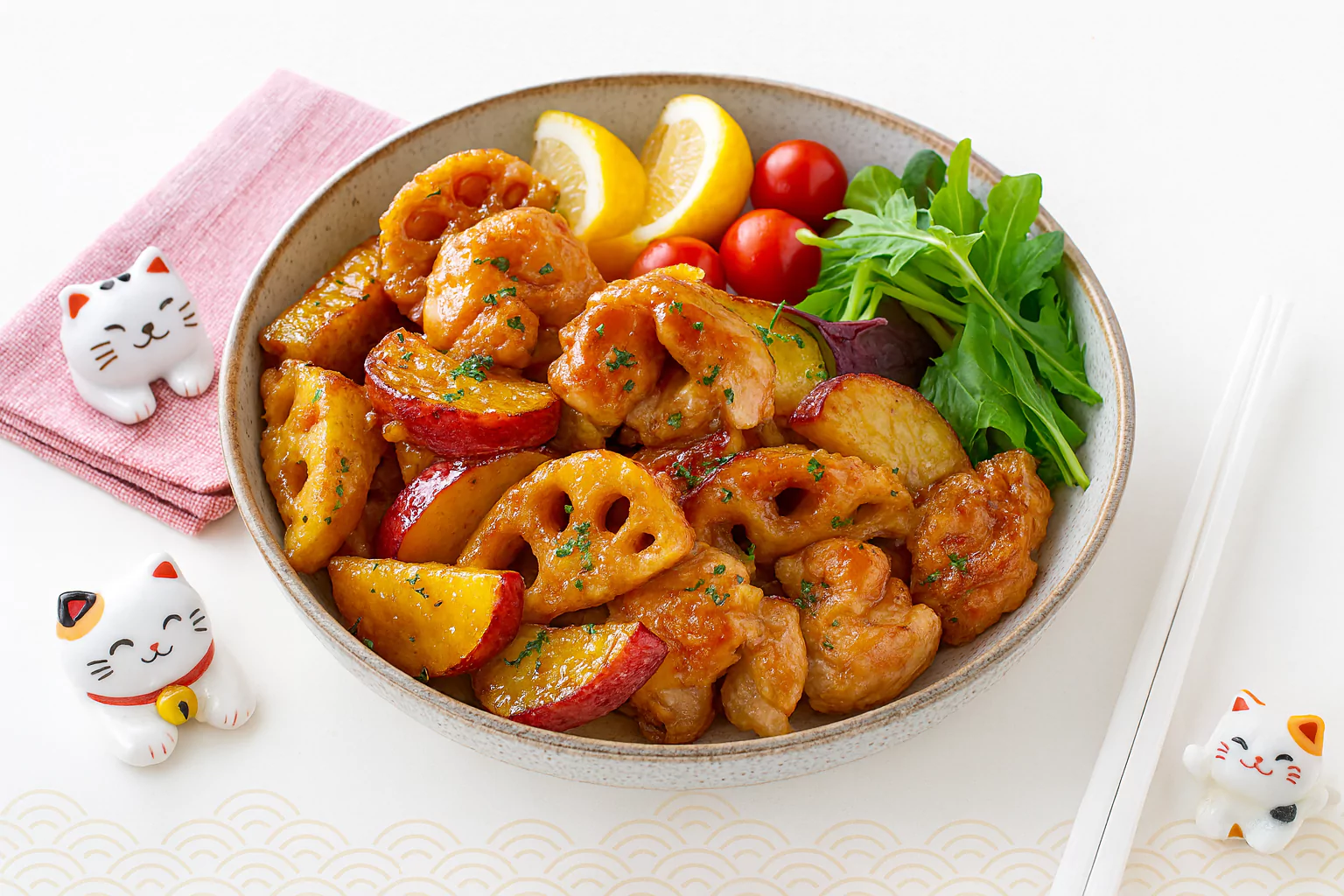Have You Ever Tried Sweet Potato in a Japanese Stir-Fry?
What if I told you that a sweet potato could star in a savory stir‑fry dish you’ll fall in love with? Most of us think of sweet potatoes in desserts or baked forms. But Satsumaimo Stir‑Fry (和風さつまいも炒め) turns that idea upside down—mixing sweetness with soy, butter, and crisp textures. Intrigued? Let’s explore how to make this treat at home (and why it’s worth the kitchen time).
What Makes This Satsumaimo Stir-Fry Special?
This dish combines simple ingredients to create a warm, comforting side or even a light main. You get a lovely balance:
- Time required: about 25–30 minutes
- Difficulty: Easy to Moderate (kid‑friendly, no hard techniques)
- Serves: 2–3 people comfortably
What makes this recipe stand out is how it brings together sweet, salty, and buttery flavors in a glistening glaze—and also the textural contrast of soft sweet potato and crunchy lotus root. This is not a heavy dish; it’s light, charming, and works well in season or any time you want a cozy Japanese‑style stir‑fry.
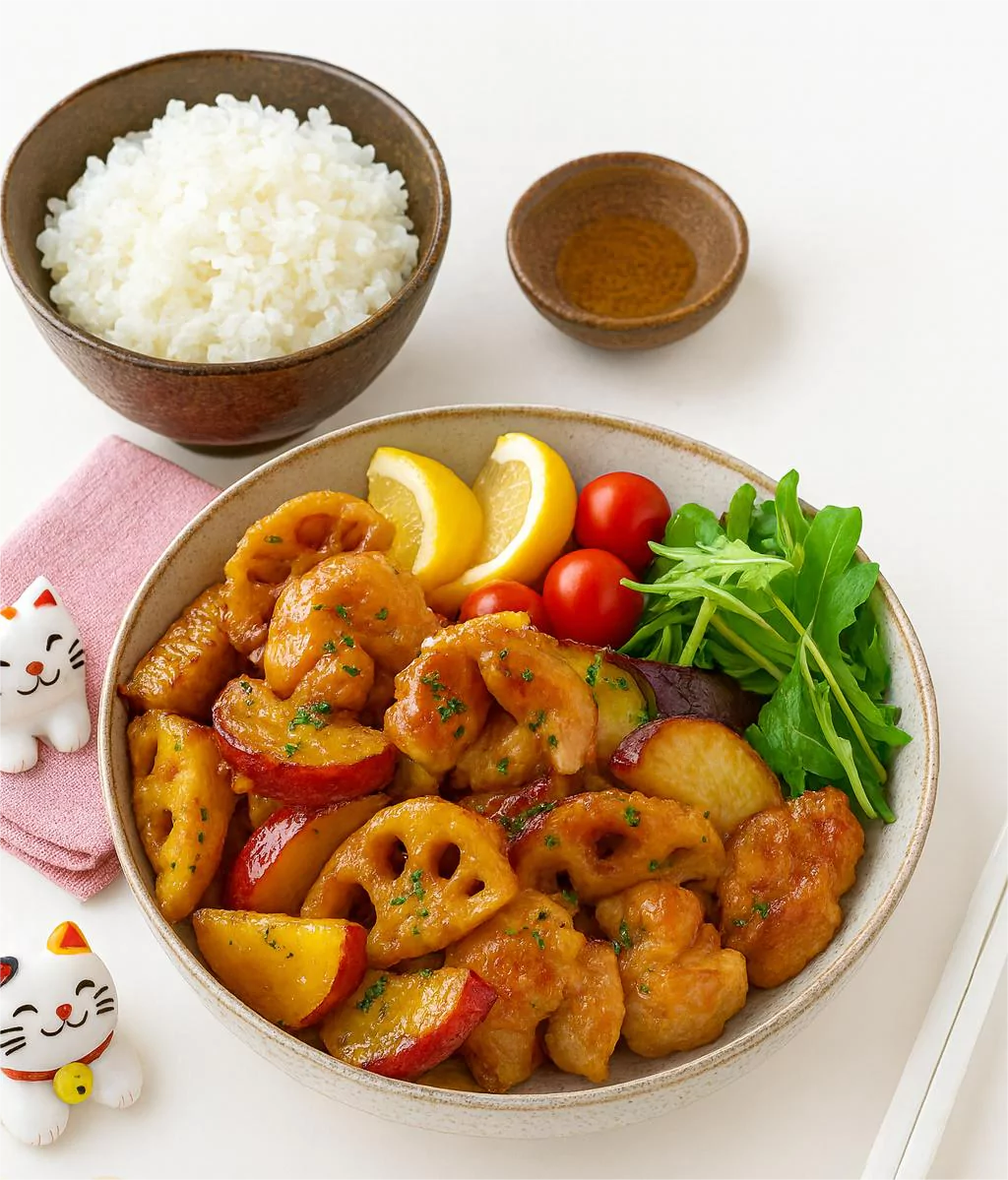
Satsumaimo Stir-Fry 和風さつまいも炒め @JapanDishes
Jump to Recipe Print RecipeWhat Is Satsumaimo Stir-Fry 和風さつまいも炒め?
In Japanese, “Satsumaimo” means sweet potato. This root vegetable is cherished for its earthy sweetness and creamy texture. “Wafu” refers to a Japanese-style flavor—usually built around soy sauce, mirin, and dashi. Satsumaimo Stir-Fry brings these elements together with a quick sauté of sweet potatoes, chicken thigh, and lotus root. It’s buttery, slightly caramelized, and has a delightful crunch from the root vegetables.
Essential Ingredients (And Why They Matter)
To make the perfect Satsumaimo Stir-Fry, each ingredient serves an important role. Here’s what you need:
Main Ingredients:
- Chicken thigh (1 sheet)
Boneless and juicy, chicken thigh cooks quickly and adds protein to the dish. You can use chicken breast if you prefer leaner meat, but thigh gives more flavor. - Sweet potato – 150g
Japanese sweet potatoes have a purple skin and yellow flesh. They are less watery and sweeter than American varieties. You can also try using regular sweet potatoes or even kabocha squash as a substitute. - Lotus root – 100g
This crunchy, starchy vegetable brings an unexpected texture. If you can’t find it, try using carrots or water chestnuts. - Potato starch – 4 tablespoons
This coats the chicken and vegetables to create a crispy outer layer. Cornstarch works in a pinch. - Salt and pepper – A little
For seasoning before frying.
Sauce A:
- Sake – 2 tablespoons
Adds depth and helps tenderize the meat. - Mirin – 2 tablespoons
Brings a subtle sweetness and glaze to the stir-fry. - Soy sauce – 4 teaspoons
Provides the umami base for the sauce. - Sugar – 1/2 teaspoon
Balances the saltiness. - Salted butter – 10g
The secret to the rich, melt-in-your-mouth flavor.
Step-by-Step Instructions
Follow these steps to create your homemade Satsumaimo Stir-Fry 和風さつまいも炒め:
Step 1: Prepare the Vegetables
- Slice the sweet potato and lotus root into 1cm thick slices.
- Use a decorative cut, like chrysanthemum-style, for a traditional touch (optional).
- Soak both in water for 10 minutes to remove excess starch and prevent discoloration.
- Drain well and pat dry with paper towels.
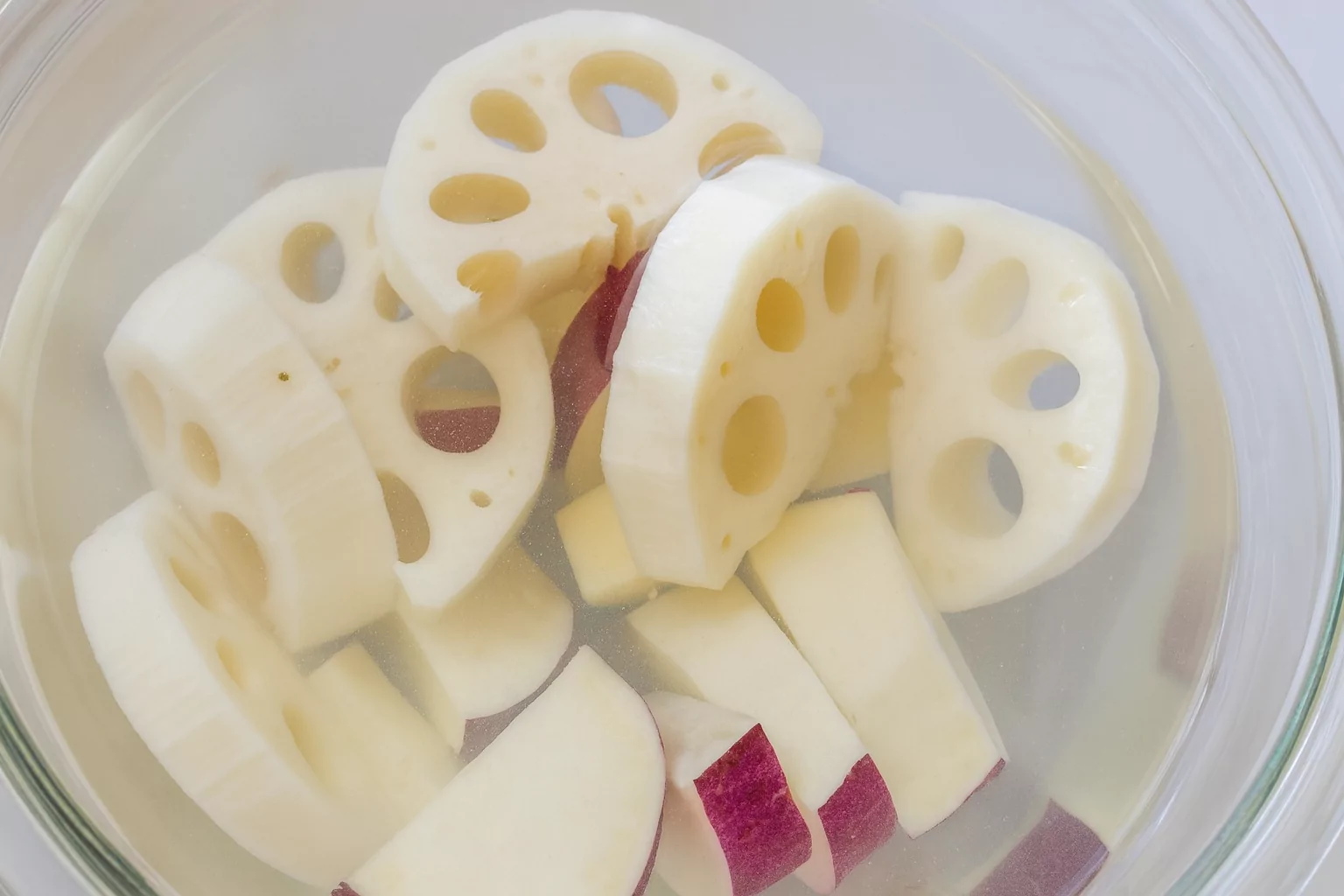
Step 2: Cut and Coat the Chicken
- Cut the chicken thigh into bite-sized pieces.
- Season lightly with salt and pepper.
- Toss the chicken, sweet potato, and lotus root in potato starch to create a light coating.

Step 3: Fry the Ingredients
- Heat 3 tablespoons of oil in a non-stick frying pan over medium heat.
- Add the coated chicken and vegetables. Fry until golden brown and crispy—about 4–5 minutes per side.
- Be careful not to overcrowd the pan to keep the ingredients crispy.

Step 4: Make the Sauce
- Wipe off any extra oil in the pan.
- Add the sauce ingredients:
- 2 tablespoons sake
- 2 tablespoons mirin
- 4 teaspoons soy sauce
- 1/2 teaspoon sugar
- 10g salted butter
- Stir gently until the sauce thickens and coats everything evenly.

Secrets to Success & Expert Tips
- Control the heat: Medium heat is your friend. If the heat is too high, butter might burn before it melts properly.
- Do not overcrowd the pan: Crowding causes steaming instead of crisping.
- Add butter last: Butter has a low smoke point, so always melt it at the very end to preserve its flavor.
- Use freshly made sauce: Don’t pre-mix sauce well in advance, or saltiness may intensify.
- Balance sweetness: If your sweet potatoes are very sweet, reduce sugar slightly; if they’re bland, you can raise sugar by a pinch.
- Garnish smartly: Toasted sesame seeds, chopped green onions, or a tiny bit of yuzu zest can lift the final dish.
Assembly & Presentation
Once everything is cooked and glazed, it’s time to present your creation.
- Place the pieces gently in a shallow, wide bowl so the sauce and ingredients are visible.
- For a clean look, arrange the vegetables and chicken alternately, or in small clusters.
- Garnish with sesame seeds, slivers of green onion, or shredded nori (seaweed) for color contrast.
- Serve with a bowl of steamed white rice (or brown rice), miso soup, or lightly pickled vegetables to make a well-rounded meal.
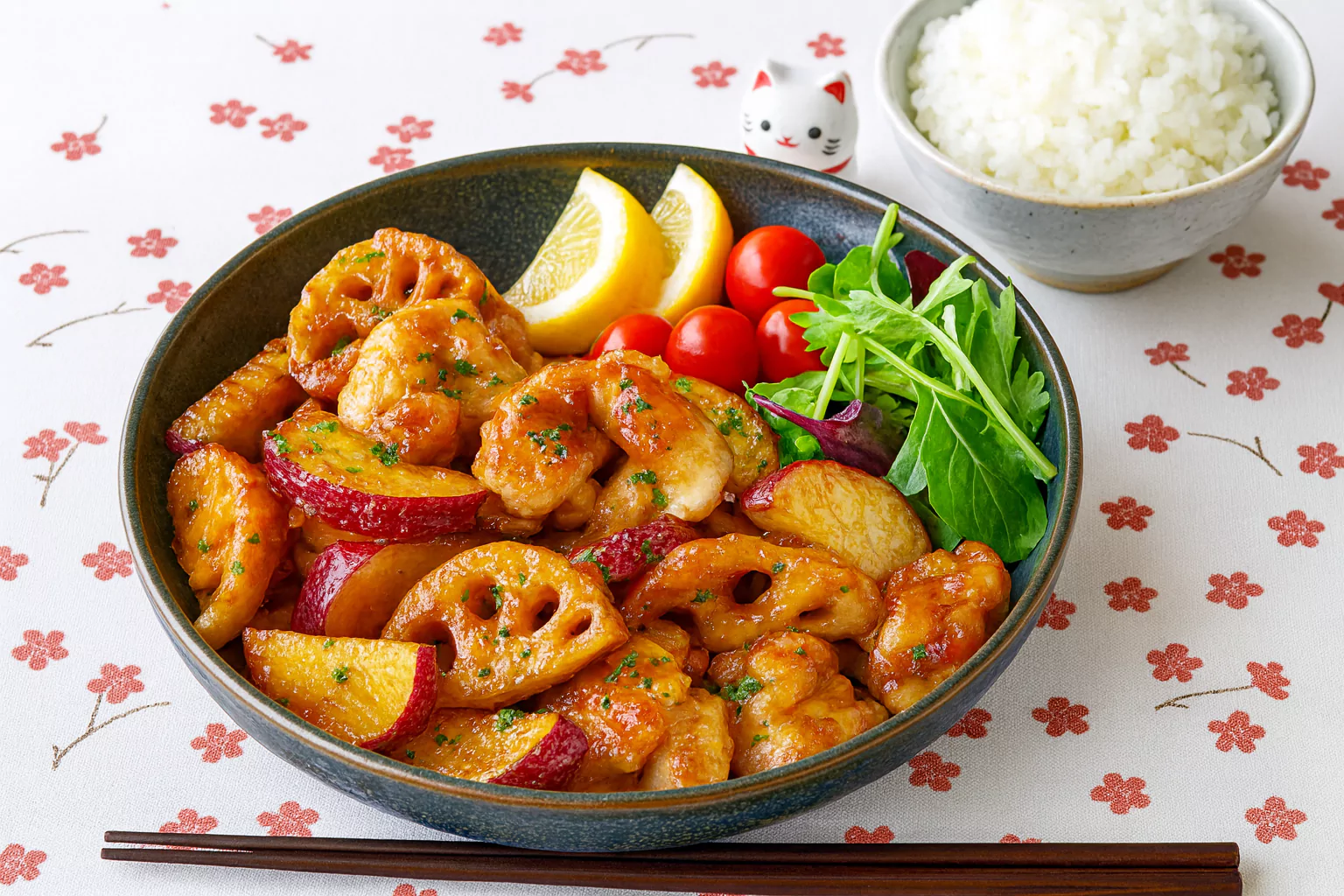
Satsumaimo Stir-Fry 和風さつまいも炒め @JapanDishes
Hana’s Recipe Tips
Hana, a home cook from Kyoto who loves autumn ingredients, has a few little tweaks:
- She often soaks the sweet potato and lotus root in water with a pinch of salt—this not only draws out starch but helps preserve color.
- She swirls the pan gently after adding butter rather than stirring violently. This helps coat each piece gently and keeps pieces intact.
- She sometimes adds a small sprinkle of dashi powder (just ¼ tsp) to deepen the flavor.
- Hana also says: “Let the dish rest for a minute off the heat so the glaze sets slightly before serving.”
Storage and Make‑Ahead Tips
Storing Leftovers
- Refrigerator: Put cooled leftovers in an airtight container. They stay good for up to 3 days.
- Freezer: This dish isn’t ideal for freezing because the texture of sweet potato changes. If you must, freeze in a single layer, then reheat gently.
Reheating Advice
- Use a low heat in a pan, adding a drop of water or butter to revive moisture.
- If microwaving, cover loosely and heat in short bursts (30 seconds), stirring in between.
Make‑Ahead Preparation
- You can pre-slice and soak the vegetables the day before.
- Keep the chicken cut and lightly seasoned in the fridge, ready to be dredged in starch and cooked the next day.
- Don’t mix sauce too early—keep the liquids separate until cooking time.
Recipe Variations to Explore
Here are some fun twists if you want to experiment:
- Vegetarian/vegan: Skip chicken. Use mushrooms (shiitake, king oyster) or firm tofu coated in starch. Replace butter with vegan butter.
- Spicy version: Stir in a little shichimi togarashi or chili oil in the final glazing step.
- Honey glaze: Replace sugar with a teaspoon of honey for a richer, more caramel-like effect.
- Add greens: Throw in spinach, bok choy, or snow peas in the last minute for freshness.
- Seafood twist: Use shrimp or scallops instead of chicken (reduce cooking time accordingly).
- Citrus hint: At the end, finish with a few drops of yuzu juice or grated peel for brightness.
If you’re interested in other Japanese home-cooked stir-fry dishes, check out this flavorful and quick Komatsuna, Bacon and Egg Stir Fry (小松菜とベーコンのたまご炒め) a perfect way to enjoy leafy greens with a savory twist. It makes a great companion to this sweet potato stir-fry on your dinner table.
Conclusion: Try It and Make It Yours
I hope this guide helps you bring out the best in Satsumaimo Stir‑Fry (和風さつまいも炒め). It’s a lovely dish that surprises with how sweet, savory, and buttery it feels, while staying light and homey. Don’t hesitate to adjust for your taste, try one variation, or add your own twist. Cooking is joyful experimentation!
If you like exploring Japanese food, culture, and travel, check out this article about a hidden gem museum in Japan: Teddy Bear Museum – why it’s a hidden gem. It’s great for those who want travel tips, food discoveries, or news about Japan. (If you ever visit, pair your cooking adventures with sightseeing!)
FAQs (Friendly Answers)
Q1: Can I use any sweet potato?
Yes! You can use Japanese sweet potatoes for best results, but regular orange sweet potatoes will work. They may be moister or more sugary, so just adjust the sugar in the sauce accordingly.
Q2: Is this dish healthy?
It is! You get fiber, vitamins, and natural sweetness from sweet potatoes and lotus root. The chicken adds protein. You control oil and sauce, so it can be quite nutritious.
Q3: How long will leftovers last?
Up to 3 days in the fridge when stored well. Reheat gently to maintain texture.
Q4: Can I make it gluten-free?
Yes—use tamari or gluten-free soy sauce. Also ensure your mirin is gluten-free (some brands hide wheat in their sauces).
Q5: Why soak the vegetables?
Soaking removes extra starch, prevents discoloration, and helps them cook more evenly. It also reduces stickiness when frying.
Q6: What to serve with it?
Simple sides are best: steamed rice, miso soup, a light salad or pickles, and maybe grilled fish. The stir-fry is versatile and pairs well with many Japanese-style meals.
Final Thought: Japanese home cooking doesn’t have to be complicated. Satsumaimo Stir-Fry is proof that simple ingredients can create something deeply satisfying. So, grab your sweet potatoes, warm up your pan, and start cooking!
Satsumaimo Stir-Fry (Sweet Potato) 和風さつまいも炒め
Course: AppetizersCuisine: JapaneseDifficulty: Easy2–3
servings15
minutes15
minutes320
kcalA cozy Japanese-style stir-fry featuring sweet potatoes, chicken, and lotus root sautéed in a buttery soy glaze. Quick, comforting, and perfect for autumn meals.
Ingredients
1 boneless chicken thigh (cut into bite-size pieces)
150 g Japanese sweet potato (sliced into 1 cm thick rounds)
100 g lotus root (sliced thin, soaked in water)
4 tablespoons potato starch (or cornstarch)
Salt and pepper (a pinch, for seasoning)
3 tablespoons vegetable oil (for frying)
- Sauce (A):
2 tablespoons sake
2 tablespoons mirin
4 teaspoons soy sauce
½ teaspoon sugar
10 g salted butter
Directions
- Slice the sweet potato and lotus root into 1 cm rounds. Soak them in water for 10 minutes to remove starch, then drain and pat dry.
- Cut chicken thigh into bite-size chunks. Lightly season with salt and pepper.
- Toss the chicken, sweet potato, and lotus root with potato starch until evenly coated.
- Heat 3 tablespoons oil in a large frying pan over medium heat. Fry chicken and vegetables until golden and crisp, turning occasionally. Remove excess oil if necessary.
- Add sake, mirin, soy sauce, sugar, and butter to the pan. Stir until butter melts and sauce thickens slightly.
- Return chicken and vegetables to the pan. Toss gently until all pieces are coated in the glaze.
- Serve warm, garnished with sesame seeds or green onions if desired.
Notes
- ✪ Japanese sweet potatoes are ideal for their creamy texture and natural sweetness, but regular sweet potatoes work too.
✪ If lotus root isn’t available, substitute with carrots or water chestnuts for crunch.
✪ To make it vegetarian, replace chicken with mushrooms or tofu and use vegan butter.
